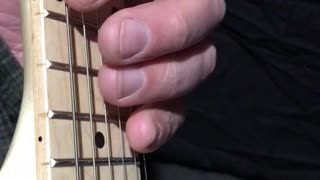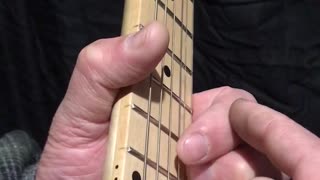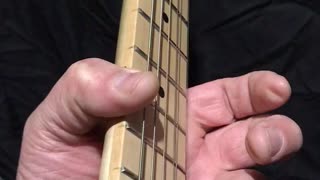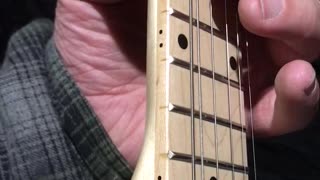Guitar Theory - Root Note and Blue Note - 6 half steps
In this exercise, we practice listening to the sound of the root note and the blue note, on the EADG strings on E standard tuned guitar.
If we did this exercise on the ADGB strings, we would have to sharpen the B string by a half step.
This shape is moveable up and down full length of the strings.
This one shape can be played for extended time, as a slide or gliss, to practice your arm intonation.
I have played this single shape for a several hour practice session, just playing along with songs i like, and i would recommend it to others as a practice idea.
To me, i think it can sound good as you move around, because no matter where your root note is, if you move the whole hand up or down a half step, the fingers that were in your blue notes will now be either on a perfect 4th or a perfect 5th, both of which sound good, and are not inherently minor or major sounds.
Theres just something about how this shape sounds, moving up and down the strings.
The blue note is 6 half steps above the root note
The blue note is exactly half way between a root and its octave
The blue note has been banned as the Devils Chord etc
The blue note can be used as a passing-note or pick-up note between P4-P5
The blue note is what distinguishes the blues scale from the minor pentatonic scale.
The blue note can be used as an anchor or pivot point, from which to find and reference other notes.
As far as my lesson plans go, this lesson is an exciting milestone, because to me it means im half-way thru all 12 half steps to an octave.
This root-blue-octave-blue shape itself is exciting because it symbolizes the half-way point on all scales and chords
This shape is easy to remember. Easy to visualize, easy to explain.
This shape also symbolizes your progress as a guitar player. from not being able to fret a single note, to being able to use all 4 fingers, to fret 4 strings, across 4 frets.
This shape can be used as the anchor, or reference, or structure, or skeleton, ...
For making future progress.
So to summarize where we started, where we are now, and where we are going...
We started at zero. 0. Silence. Mute. Rest.
Then we learned the names of the open guitar strings, EADGBE,
and then we learned that the 2 dots at the 12th fret signify the exact center of the scale length of the string, from nut to bridge.
2 dots in sheet music means repeat,
and 2 dots on a guitar fingerboard also means repeat.
So at the 12th fret, the notes on each string repeat, and so we get EADGBE again, just an octave higher.
And so we used the 12th fret as our arbitrary root note, and practiced maneuvers and shapes based on that root note.
So we learned the root note is the first note,
And then we went up, one half step at a time, 1,2,3,4,5,6 half steps
And then we learned the proper names of 2nd notes (1 and 2 half steps)
(minor 2 and Major 2)
And then we learned the 3rd notes (3 and 4 half steps)
(minor 3 and Major 3)
And then we learned about the Perfect 4th, which is a huge milestone. 5 half steps.
And here we are now at the blue note, at 6 half steps.
Next, will be 7 half steps, or a perfect 5th, which is another huge milestone, equally important to the perfect 4th.
And after that, all that will be left is the 8,9,10,11,12 half steps, also known as the
minor 6th and Major 6th ( 8 and 9 half steps)
minor 7th and Major 7th (10 and 11 half steps)
And then back to the root note at the 12th half step, otherwise known as the 8th note or
Octave
-
 15:41
15:41
Beginner Guitar
11 months agoMaking a custom guitar pick (3 of 3)
159 -
 0:50
0:50
Beginner Guitar
3 years agoGuitar Theory - The Blue Note - 6 half steps
110 -
 0:23
0:23
Beginner Guitar
3 years agoGuitar Listening Exercises - Root, 1 half step, 2 half steps, 3 half steps
37 -
 0:48
0:48
Beginner Guitar
3 years agoBeginner Guitar Listening Exercises - Root thru 5 half steps
52 -
 1:13
1:13
Beginner Guitar
3 years agoGuitar Theory - The D shape
89 -
 0:43
0:43
Beginner Guitar
3 years agoSlide Finger from Root up to 5 half steps
58 -
 0:55
0:55
Beginner Guitar
3 years agoGuitar Theory - combining two shapes into a bigger chord
52 -
 4:46
4:46
CrumblyCake
3 years agoCMP# 301 Pentatonic Theory/Application Guitar Backing Track
65 -
 1:00
1:00
Beginner Guitar
3 years agoGuitar Shapes and Intervals - Minor 3rd - 3 half-steps above root note
65 -
 0:50
0:50
Beginner Guitar
3 years agoPlaying Guitar By Ear - Listening to the Root note and Perfect 4th
66